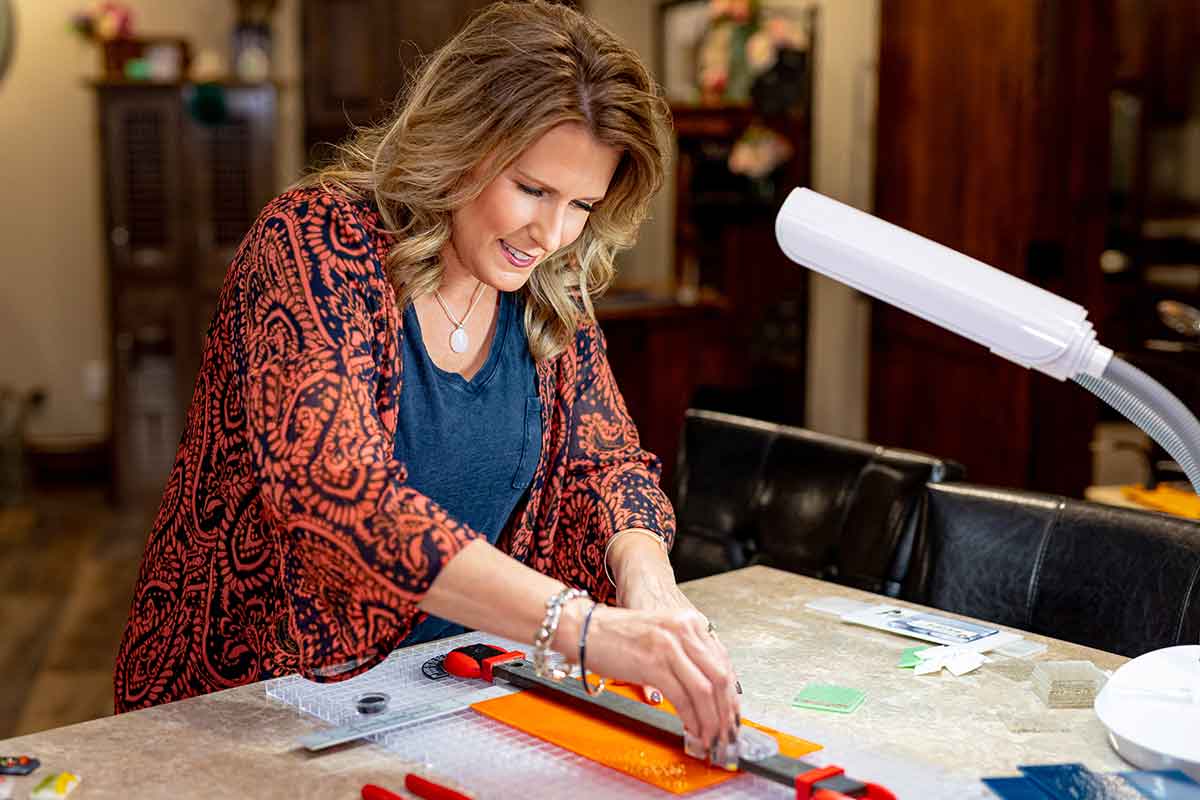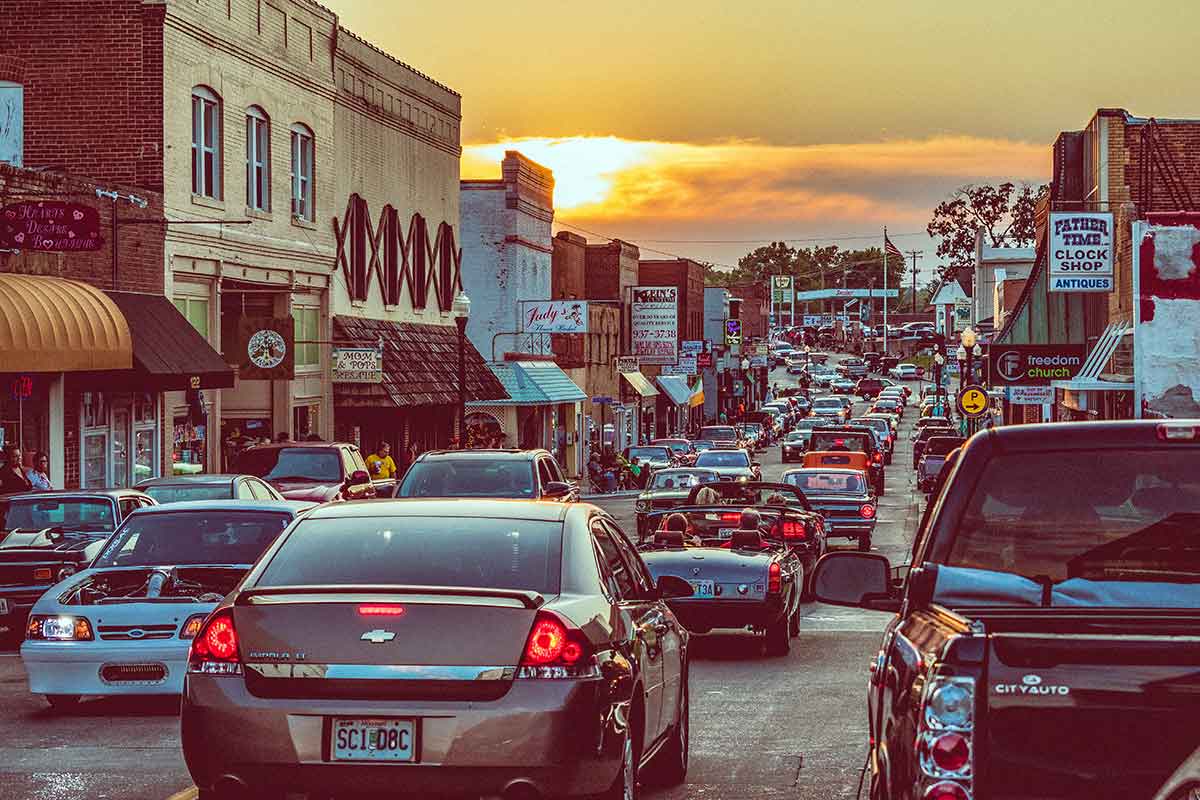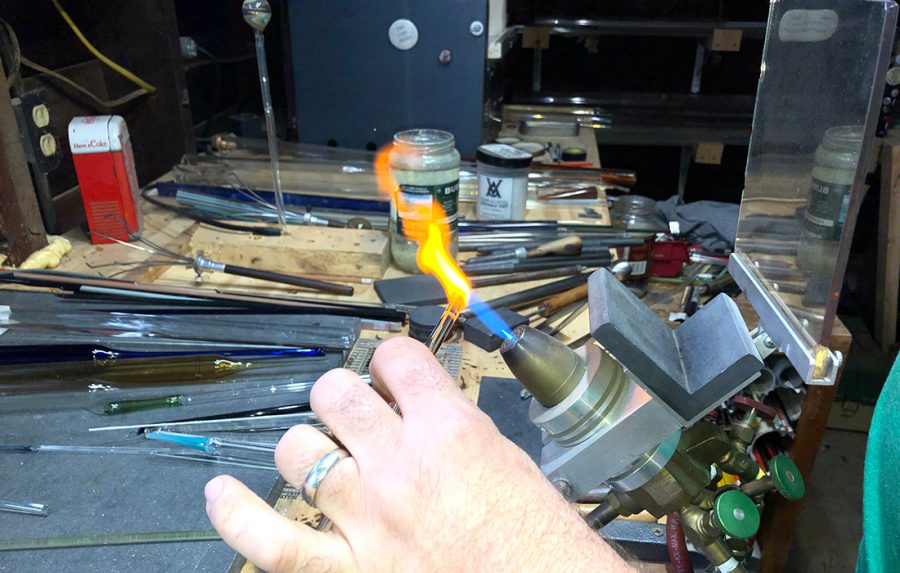Bold color and form define Callaway County artist Jane Mudd’s work
This article originally appeared in our November/December 2021 edition.
I drive down a rural country road in Callaway County toward the home and studio of artist Jane Mudd. Jane lives with her husband Tom in a log home deep in the woods, about seven miles from Fulton. I turn up the driveway to the Mudd’s home and notice that the recent rain has left the countryside lush and beautiful.
As I step out of the car, I see their house with a barn-like structure next door that serves as the couple’s workshop and studio. I spot Jane and Tom on their porch.
“You caught us dancing!” Jane laughs as I approach, stepping into their outdoor room with a million-dollar view of a verdant valley surrounded by Callaway County’s wooded hills.
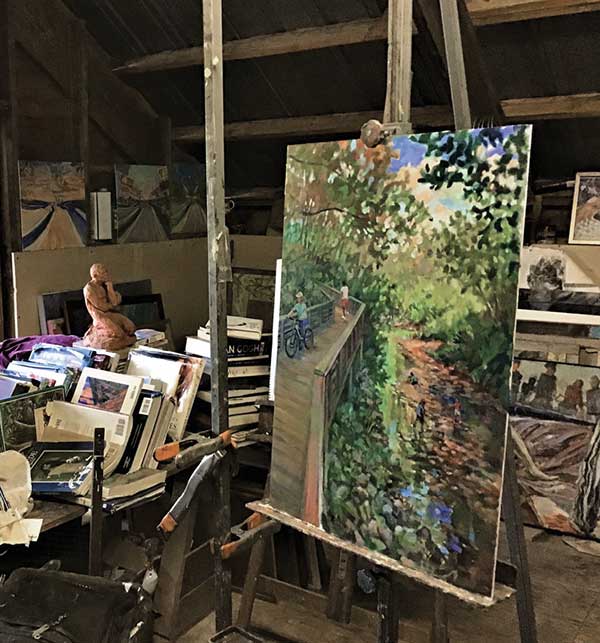
Cattle and a passion for art.
I immediately see artwork all around me, and Jane gives me a quick tour of her house. An oversized still life greets me in a passageway leading to the living room. Jane calls this picture Thanksgiving Bouquet; it comprises native grasses and wildflowers found on their property. The Mudds have been encouraging the growth of sustainable Missouri plants on their land and have worked to develop prairie habitats in several areas.
They also have cattle on some farmland for which Tom and his brother care. Since retiring as a professor of art from William Woods University in Fulton a few years ago, Jane has had more time to work on improvements to the land, as well as the home and studio she shares with her husband. With her three kids now grown, however, she is devoting the lion’s share of her time to art, her life’s passion.
Jane grew up in West County, St. Louis, in the 1960s and 1970s and received a degree in art from Fontbonne University in 1976. She met her husband on a bus trip to Colorado and was surprised to find that they both had the same birthday. The two reconnected in Missouri and eventually married and bought land in Callaway County. There they reassembled a double-pen log barn that they dismantled and moved from Berger. The home has a view of a mid-Missouri valley and Crows Fork Creek. As the Mudd family grew, caring for three kids occupied much of Jane’s time, but she never stopped painting and drawing.
In her kitchen she shows me some hand-painted tiles she created years ago that illustrate the story of her and Tom’s life together. I see images of Colorado, their first baby, and the saga of building their Callaway home.
Beginnings and budding confidence.
Jane started exhibiting her artwork at mid-Missouri venues in the late 1980s, and she encountered other artists who admired her work and encouraged her to pursue a master of fine arts. She enrolled in graduate school at the University of Missouri-Columbia, and although she specialized in painting, she also experimented with sculpture, ceramics, and pastel. She loved her art history classes and drew inspiration from past artists, as well as fellow students and supportive professors who helped her gain the confidence to experiment with bold color and form.
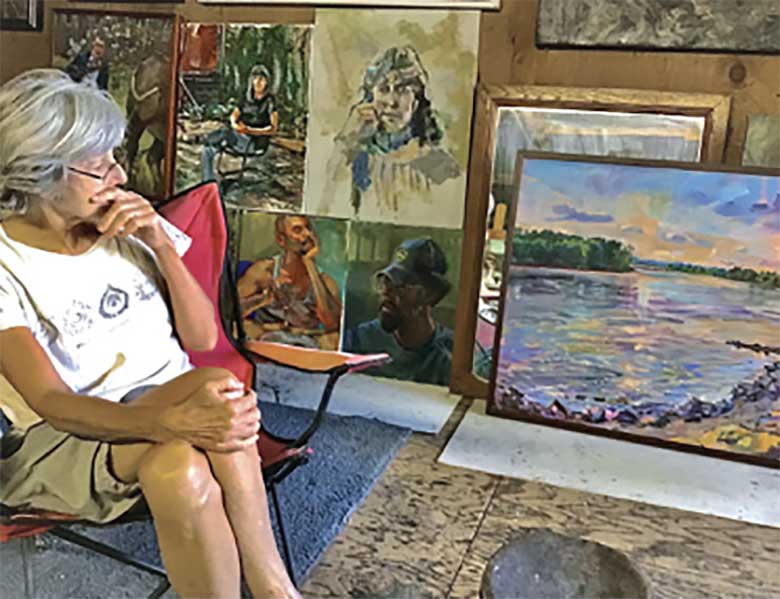
I ask her about the landscapes in her studio, and we talk about a nearby canvas representing the Missouri River. Jane enjoys plein-air painting and likes to work at her easel outside. She shows me a backpack that she takes with her on these expeditions. Inside are paints, palettes, brushes, and bug spray. Jane explains that she loves painting water, which she believes represents the ever-changing energy of nature. The water of rivers and creeks is in constant motion, reflecting the sky, trees, and everything around it. These reflections change depending on the weather, season, and time of day.
Jane points out that although the flow of water changes, the movements and currents repeat themselves, and her brush strokes follow these fluid motions and capture their transient beauty. Jane also observes that each color gains power and meaning from its adjacent hues. The pale orange pigment that represents reflections of sunlight, for example, appears more vibrant because it contrasts with the adjacent cool, complementary blue tones.
Jane’s interest in landscape extends beyond the aesthetic. She is a strong supporter of environmental and conservation initiatives and recently provided artwork to Missouri Conservationist magazine. She says she feels a duty as an artist to use her art to make the world a better place. She has accomplished this in creative ways, from donating artworks to charity auctions to painting pictures that make social statements. Recently she worked with a homeless shelter to create portraits of some of the displaced people living there. She exhibited the series at the Montminy Gallery at the Boone County History and Cultural Center, calling attention to the humanity of the people in the portraits. She sold some of the pictures and donated the proceeds to the shelter.
Collections and commissions.
Jane is also fascinated by cultural history and shows me a collection of arrowheads and stone tools that she and her husband have collected on their Callaway County property. She understands Missouri has a complex and diverse cultural past, and she was able to explore some of this history in a recent Jefferson City commission to create a painting representing Lohman’s Landing in the 1850s. Jane had fun visualizing the hustle and bustle of a place where steamboats docked, and White settlers, immigrants, and enslaved and indigenous people interacted. Jane shows merchants, farmers, and dock workers who shipped goods downriver and picked up supplies.
The artist explains that she hopes to keep viewers engaged as they look at pictures like these and writes that when it comes to historical commissions, “the more research I do, the more excited I get about the project.”
Even Jane’s historical artworks engage with the zeitgeist of the times, and the sculptures on her work table are cases in point. One represents the head of an early hominid, and another depicts Alexander Hamilton. The image of Hamilton obviously brings to mind the recent and renowned Broadway show, but I am curious about why Jane made the bust of the early human. The artist explains that she has been fascinated by prehistoric hominids for years and that she has painted several pictures in which she attempts to imagine the lives these people lived millions of years ago. For me, the bust calls attention to what makes us human, and I am reminded that modern humans have drastically transformed our planet and ecosystems since the days of Homo erectus—not always for the better.
Even Jane’s historical artworks engage with the zeitgeist of the times, and the sculptures on her work table are cases in point.
Jane’s curious mind is evident everywhere in the studio. I see a wide variety of books piled on a nearby table—everything from a coffee-table book on Rembrandt van Rijn to a dictionary of signs and symbols. Jane says that she likes to challenge herself with what-if questions and artworks that stimulate conversation and thought. She has worked with the Columbia Missouri Art League and a Kansas City arts group to create images inspired by the work of regional poets. Artists are matched with poets, who are challenged to produce a poem inspired by a picture, while the artists produce an artwork inspired by a poem. These collaborations end with an exhibition in which the artworks and poems are shown side by side. Jane shows me several paintings she made for this exhibition, including one inspired by a poem about laying aside the material things associated with the toil of work. In the foreground a pile of discarded material goods lie abandoned in front of a verdant natural landscape. The picture calls to mind the poem and also reminds viewers of all the material “stuff” humans consume and throw away, leaving future generations to deal with what is left behind.
I ask Jane about other projects she is working on, and she suggests that I visit her the next day at her other mid-Missouri studio on Orr Street in Columbia. Jane was among the first group of artists who occupied Orr Street Studios when it first opened in 2007, and she now serves on that organization’s board. Jane loves the camaraderie that exists between the different artists at Orr Street, where a variety of painters, sculptors, photographers, and more occupy the many one-room studios that surround a shared space for exhibitions and events.
Jane’s Orr Street space is smaller than her home studio, but the walls are covered in beautiful landscapes, portraits, and figure paintings. Two recent paintings could only have been painted in the twenty-first century: one shows a studio model wearing a face mask, and the other depicts a model looking at her smartphone.
I am especially intrigued by a landscape depicting multiple cows, goats, and a single pig crowded together in the middle of a road. Jane tells me the picture was inspired by a scene that greeted her one morning on a drive into town. The image captures the richness of the early dawn colors as well as the artist’s signature wit. Like many of Jane’s works, this painting celebrates the joy of life, from the sublime to the absurd.
I ask Jane if she works differently when she is at Orr Street, and she tells me she likes the stimulation of the Columbia studio where she can bounce ideas off other artists but admits that her most creative moments tend to occur on her Callaway County property.
I feel lucky to have visited both places.
— Joan Stack is curator of art collections for The State Historical Society of Missouri in Columbia.
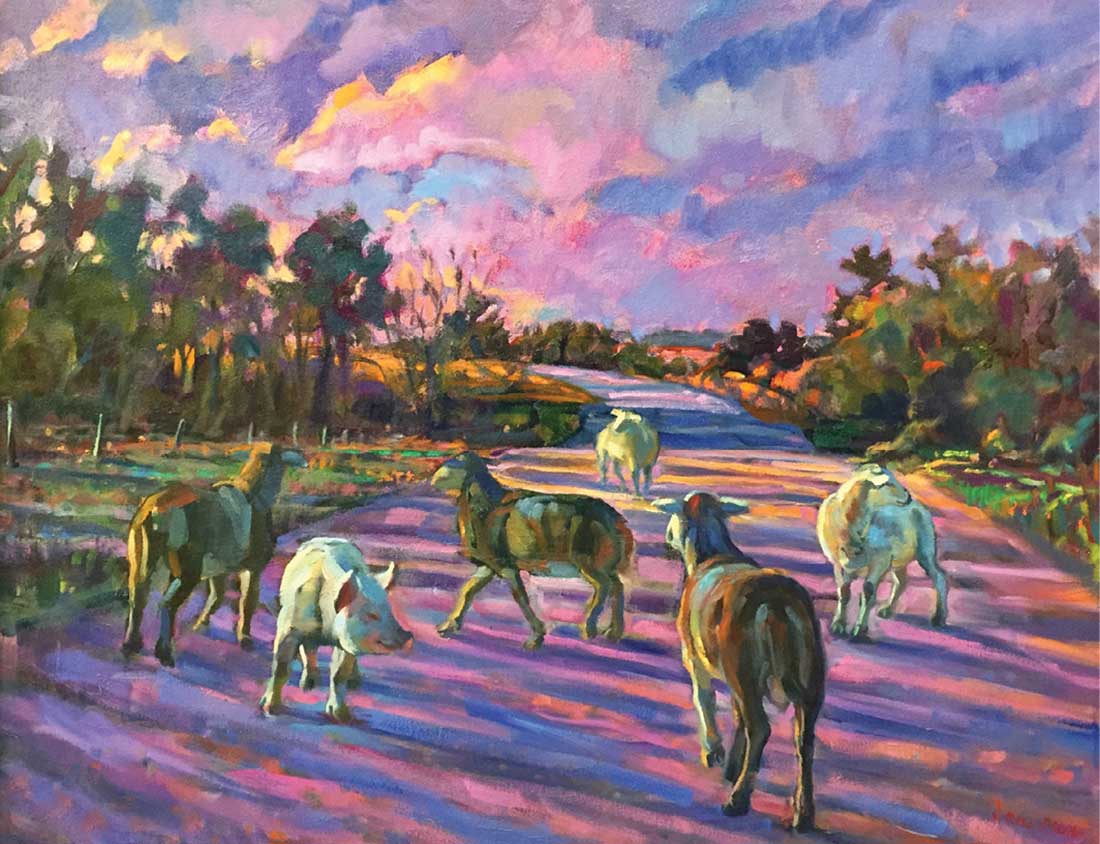
Related Posts
Revitalizing Missouri Downtowns
Here’s how Missourians are working together to revitalize downtowns across the state.
Rocheport Artist Shawn Palmer Creates Glass Artwork
Time and skill goes into creating the perfect glass artwork. Rocheport artist, Shawn Palmer, shares his craft.

